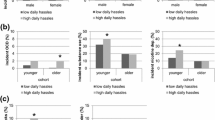Abstract
The purpose of this study was to investigate the reliability and validity of a Panic Attack Frequency Calendar (PAFC), modeled after a time-line follow-back (TLFB) procedure (e.g., Sobell & Sobell, 1979). The latter has been used for years to reliably and validly assess daily alcohol use through self-report over extended periods of time. Seventy-four adult individuals (ages 18–57) who had experienced a panic attack within the past 2 weeks completed a battery of self-report questionnaires, including retrospective frequency measures, and were administered an 8-week PAFC initially and a 10-week PAFC 2 weeks later. Half the participants self-monitored their panic attacks in a diary. The PAFC showed high stability over 2 weeks across several panic behavior variables. The PAFC was also shown to be a valid instrument in assessing panic frequency when compared with panic data obtained from the diary and the retrospective frequency measure.
Similar content being viewed by others
REFERENCES
American Psychiatric Association. (1994). Diagnostic and statistical manual of mental disorders (4th ed.). Washington, DC: Author.
Barlow, D. H., &; Cerny, J. A. (1988). Psychological treatment of panic. New York: Guilford.
Barlow, D. H., Craske, M. G., Cerny, J. A., &; Klosko, J. S. (1989). Behavioral treatment of panic disorder. Behavior Therapy, 20, 261–282.
Beck, A. T., Ward, C. H., Mendelson, M., Mock, J., &; Erbaugh, J. (1961). An inventory for measuring depression. Archives of General Psychiatry, 4, 561–571.
Beck, J. G., &; Zebb, B. J. (1994). Behavioral assessment and treatment of panic disorder: Current status, future directions. Behavior Therapy, 25, 581–611.
Brown, T. A., DiNardo, P. A., &; Barlow, D. H. (1994). Anxiety disorders interview schedule for DSM-IV. Albany, New York: Graywind Publications, Inc.
Chambless, D. L., Caputo, G. C., Bright, P., &; Gallagher, R. (1984). Assessment of fear in agoraphobics: The body sensation questionnaire and the agoraphobic cognitions questionnaire. Journal of Consulting and Clinical Psychology, 52, 1090–1097.
Chambless, D. L., Caputo, G. C., Jasin, S. E., Gracely, E. J., &; Williams, C. (1985). The mobility inventory for agoraphobia. Behaviour Research and Therapy, 23, 35–44.
Clum, G. A., Broyles, S., Borden, R. J., &; Watkins, P. L. (1990). Validity and reliability of the panic attack symptoms and cognitions questionnaires. Journal of Psychopathology and Behavioral Assessment, 12, 233–245.
Cote, G., Gauthier, J. G., Laberge, B., Cormier, H. J., &; Plamondon, J. (1994). Reduced therapist contact in the cognitive behavioral treatment of panic disorder. Behavior Therapy, 25, 123–145.
de Beurs, E., Garssen, B., Buikhuisen, M., Lange, A., van Balkom, A., &; Van Dyck, R. (1994). Continuous monitoring of panic. Acta Psychiatrica Scandinavica, 90, 38–45.
de Beurs, E., Lange, A., &; Van Dyck, R. (1992). Self-monitoring of panic attacks and retrospective estimates of panic: Discordant findings. Behaviour Research and Therapy, 30, 411–413.
Gould, R. A., &; Clum, G. A. (1995). Self-help plus minimal therapist contact in the treatment of panic disorder: A replication and extension. Behavior Therapy, 26, 533–546.
Margraf, J., Taylor, C. B., Ehlers, A., Roth, W. T., &; Agras, W. T. (1987). Panic attacks in the natural environment. Journal of Nervous and Mental Disease, 175, 558–565.
Rapee, R. M., Craske, M. G., &; Barlow, D. H. (1990). Subject-described features of panic attacks using self-monitoring. Journal of Anxiety Disorders, 4, 171–181.
Reiss, S., Peterson, R. A., Gursky, D. M., &; McNally, R. J. (1986). Anxiety sensitivity, anxiety frequency, and the prediction of fearfulness. Behaviour Research and Therapy, 24, 1–8.
Sobell, L. C., &; Sobell, M. B. (1979). Validity of self-reports in three populations of alcoholics. Journal of Consulting and Clinical Psychology, 46, 901–907.
Sobell, L. C., &; Sobell, M. B. (1992). Time-line follow-back: A technique for assessing self-reported alcohol consumption. In R. Z. Litten &; J. P. Allen (Eds.), Measuring alcohol consumption: Psychosocial and biochemical methods (pp. 41–72). Totowa, NJ: Humana.
Sobell, M. B., Maisto, S. A., Sobell, L. C., Cooper, A. M., Cooper, T. C., &; Sanders, B. (1980). Develo** a prototype for evaluating alcohol treatment effectiveness. In L. C. Sobell, M. B. Sobell, &; E. Ward (Eds.), Evaluating alcohol and drug abuse treatment effectiveness: Recent advances. New York, NY: Pergamon.
Spielberger, C. D., Gorsuch, R. L., Lushene, R., Vagg, P. R., &; Jacobs, G. A. (1983). Manual for the State-Trait Anxiety Inventory (Form Y). Palo Alto, CA: Consulting Psychologists Press.
Author information
Authors and Affiliations
Corresponding author
Rights and permissions
About this article
Cite this article
Nelson, W.A., Clum, G.A. Assessment of Panic Frequency: Reliability and Validity of a Time-Line Follow-Back Method. Journal of Psychopathology and Behavioral Assessment 24, 47–54 (2002). https://doi.org/10.1023/A:1014053224844
Issue Date:
DOI: https://doi.org/10.1023/A:1014053224844



